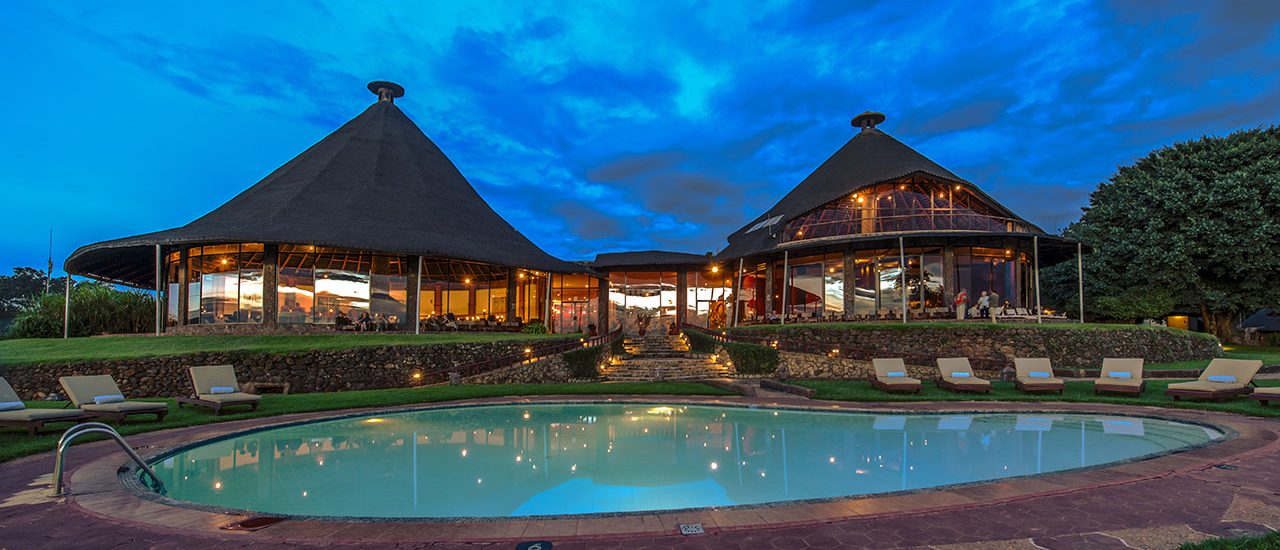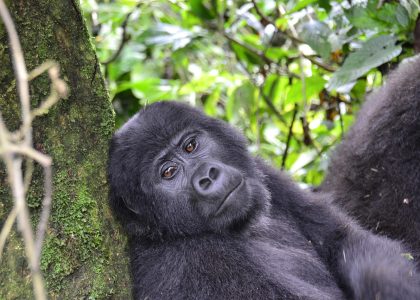Continuing our Wazimba Travel Tanzania series, we invite you to discover wildlife experiences that extend beyond the typical safari circuit. While Tanzania is rightfully famous for its lion, elephant, and wildebeest sightings across the Serengeti, the country offers an extraordinary range of unique wildlife encounters that showcase its remarkable biodiversity. From chimpanzee tracking in ancient forests to underwater whale shark encounters, these exceptional experiences add unforgettable dimensions to your Tanzanian adventure.
Chimpanzee Tracking in Tanzania’s Western Forests
Tanzania hosts some of Africa’s most significant wild chimpanzee populations in its remote western forests, offering arguably the continent’s most intimate great ape encounters.
Gombe Stream National Park
Made famous by Jane Goodall’s groundbreaking research, Gombe Stream is the world’s longest-running chimpanzee research site. Despite being Tanzania’s smallest national park at just 52 square kilometers, this pristine forest along Lake Tanganyika’s shores provides extraordinary chimpanzee encounters:
- Follow expert guides through dense forest to observe chimpanzee families exhibiting complex social behaviors
- Watch the chimps make and use tools, groom each other, and communicate with distinctive calls
- Visit Jane Goodall’s original research station to learn about her pioneering work studying our closest genetic relatives
- Combine chimpanzee tracking with extraordinary birdwatching, red colobus monkey sightings, and pristine beach relaxation along Lake Tanganyika
Wazimba Travel arranges multi-day Gombe experiences that include comfortable lake-side accommodations and knowledgeable guides who maximize your chances of meaningful chimpanzee observations.
Mahale Mountains National Park
For the ultimate chimpanzee experience, Mahale Mountains National Park offers even more reliable encounters within an extraordinarily scenic setting:
- Track the famous M-group of chimpanzees, comprising about 60 individuals habituated to human presence
- Experience one of Africa’s most beautiful landscapes where forested mountains cascade down to the crystal-clear waters of Lake Tanganyika
- Observe not just chimpanzees but also yellow baboons, red colobus, blue and red-tailed monkeys
- Combine wildlife tracking with kayaking, fishing, and swimming in the pristine lake waters
Wazimba Travel Tips for Chimpanzee Tracking:
- Book well in advance—these parks have limited visitor capacity
- Plan at least two tracking days to maximize chances of quality encounters
- The dry season (May-October) offers the best tracking conditions
- Wear long sleeves, pants, and sturdy hiking boots for forest walks
- Follow all guide instructions regarding distance and behavior around the chimps
Tanzania: A Birdwatcher’s Paradise
With over 1,100 bird species—more than 10% of the world’s avian diversity—Tanzania offers extraordinary birdwatching opportunities across dramatically different ecosystems.
Prime Bird Watching Locations:
Arusha National Park: Just minutes from Tanzania’s safari gateway city, this compact park features diverse habitats hosting over 400 bird species. Look for the striking silvery-cheeked hornbill, Hartlaub’s turaco, and numerous waterfowl around Momella Lakes.
Usambaras Mountains: These ancient Eastern Arc Mountains harbor numerous endemic species found nowhere else, including the Usambara eagle-owl, Usambara weaver, and the striking Usambara akalat. The cool montane forests provide a refreshing contrast to safari plains.
Manyara and Natron: These alkaline lakes host spectacular flamingo congregations, sometimes numbering in the millions. The sight of these pink masses against dramatic Rift Valley backdrops creates unforgettable photography opportunities.
Ngorongoro Crater: Beyond Big Five mammals, the crater hosts over 500 bird species, with highlights including the massive kori bustard, the endangered lappet-faced vulture, and colorful Fischer’s lovebirds.
Rubondo Island National Park: This Lake Victoria island sanctuary is home to African fish eagles, numerous kingfishers, and the highly endangered shoebill stork in surrounding swamps.
Wazimba Travel Tips for Birdwatching:
- Our specialized bird guides carry high-quality spotting scopes and reference materials
- We provide species checklists to track your sightings
- Early morning and evening excursions yield the most active bird observations
- Our vehicles feature roof hatches ideal for bird photography
- Consider adding dedicated birding days to your standard safari itinerary
Marine Wonders Along Tanzania’s Coast
Tanzania’s Indian Ocean waters host extraordinary marine wildlife encounters that rival its terrestrial safaris in excitement and biodiversity.
Whale Shark Encounters
Between October and March, the waters around Mafia Island host one of the world’s most reliable seasonal concentrations of whale sharks. These gentle giants—the world’s largest fish—feed on plankton blooms in the channel between Mafia and the mainland coast.
Wazimba Travel arranges responsible snorkeling experiences that follow strict guidelines:
- Maximum six swimmers per whale shark
- No touching or riding these protected creatures
- Maintaining appropriate distances to prevent stress
- Experienced guides who understand whale shark behavior
The experience of swimming alongside these massive, spotted creatures (reaching up to 12 meters in length) creates lifetime memories while supporting local conservation efforts through sustainable tourism.
Dolphin Watching and Swimming
Several dolphin species frequent Tanzania’s coastal waters, with particularly reliable sightings in:
Menai Bay Conservation Area (Zanzibar): Home to resident populations of Indo-Pacific bottlenose and humpback dolphins. Early morning excursions offer the best chance to observe these intelligent mammals in their natural habitat.
Kizimkazi (South Zanzibar): Known for ethical dolphin interaction programs, where dolphins approach boats on their own terms. Our guided excursions emphasize responsible observation over guaranteed close encounters.
Mafia Island: Less crowded than Zanzibar, Mafia’s waters host spinner and bottlenose dolphins year-round. The combination of healthy dolphin populations and fewer tourist boats creates more natural encounters.
Sea Turtle Conservation
Five sea turtle species nest on Tanzania’s beaches and islands. Through partnerships with conservation programs, Wazimba Travel offers meaningful turtle experiences:
- Turtle Hatching: Seasonal opportunities (February-July) to witness baby turtles scampering to the sea on protected beaches
- Turtle Rehabilitation: Visit rescue centers on Zanzibar and Mafia Islands where injured turtles receive care
- Snorkeling with Turtles: Several marine protected areas offer reliable encounters with foraging green and hawksbill turtles
World-Class Snorkeling and Diving
Tanzania’s coral reefs support vibrant marine ecosystems. Top experiences include:
Mnemba Atoll (Zanzibar): A marine conservation area with exceptional coral gardens and visibility, accessible as a day trip from most Zanzibar locations.
Mafia Island Marine Park: Tanzania’s first marine park protects extraordinary coral diversity and reef fish populations, with minimal tourist crowds.
Pemba Island: Steep underwater walls and pinnacles provide dramatic diving for experienced underwater explorers.
Wazimba Travel arranges marine experiences for all skill levels, from first-time snorkelers to advanced divers seeking technical challenges.
The Great Migration River Crossings
While the Serengeti-Mara ecosystem’s Great Migration is well-known, witnessing the dramatic river crossings represents a rare wildlife spectacle requiring precise timing and insider knowledge.
Grumeti River Crossings (May-July)
As the wildebeest herds move northward through the Western Corridor of Serengeti National Park, they must cross the crocodile-infested Grumeti River. This creates dramatic scenes as thousands of animals brave dangerous waters while predators await. Wazimba Travel’s expert guides know exactly where to position vehicles for optimal viewing.
Mara River Crossings (July-October)
The most famous migration spectacle occurs when the herds cross the Mara River between Tanzania’s Northern Serengeti and Kenya’s Maasai Mara. Enormous crocodiles, steep riverbanks, and strong currents create nature’s ultimate drama as thousands of wildebeest and zebra make their desperate crossings.
Wazimba Travel Tips for River Crossings:
- Book at least a year in advance for peak crossing seasons
- Plan minimum three days in crossing areas to maximize chances of witnessing this unpredictable event
- Our guides communicate via radio networks to share crossing intelligence
- Northern Serengeti accommodations offer crossing access with smaller crowds than Kenyan sectors
- Patience is essential—animals may gather at riversides for hours before crossing
Endangered Species Encounters
Tanzania provides sanctuary for several critically endangered species that offer profound conservation connections for wildlife enthusiasts.
Eastern Black Rhino
Once widespread across East Africa, fewer than 1,000 eastern black rhinos remain in the wild. Tanzania protects significant populations in:
Ngorongoro Crater: The crater floor provides a natural sanctuary where rhinos can be observed with relative reliability.
Mkomazi National Park: Visit the Mkomazi Rhino Sanctuary, where a breeding program works to restore black rhino populations. Wazimba Travel can arrange behind-the-scenes conservation tours to learn about anti-poaching efforts and breeding successes.
Wild Dogs
The African wild dog (painted wolf) has disappeared from much of its former range, but Tanzania remains a stronghold for these highly endangered social hunters:
Nyerere National Park (formerly Selous Game Reserve): Home to Tanzania’s largest wild dog population, with good sighting possibilities during denning season (June-August).
Ruaha National Park: Supports multiple wild dog packs that can be tracked with knowledgeable guides. Our multi-day Ruaha itineraries maximize your chances of observing these fascinating predators.
Grevy’s Zebra
The largest and most endangered zebra species occasionally appears in Tanzania’s northern border regions. Special Wazimba Travel expeditions to remote northern Tanzania provide opportunities to observe these distinctive, narrow-striped zebras alongside their more common plains zebra cousins.
Bat Migration at Kasanka (Seasonal Extension to Zambia)
For truly unique wildlife spectacle, Wazimba Travel offers extensions to witness the world’s largest mammal migration at Kasanka National Park in neighboring Zambia:
- Up to 10 million straw-colored fruit bats gather in a tiny forest patch from October to December
- The evening exodus creates an astonishing natural spectacle as the sky darkens with countless bats
- This extension combines perfectly with western Tanzania chimpanzee experiences
Ethical Wildlife Tourism Practices
As you plan your extraordinary wildlife experiences beyond Tanzania’s famous safari circuit, embracing ethical tourism practices ensures your visit contributes positively to conservation:
Respect Wildlife Space:
- Maintain appropriate distances from all wildlife
- Never attempt to touch or feed wild animals
- Keep voices low and movements minimal during wildlife viewing
- Follow all guide instructions regarding safety and animal welfare
Choose Responsible Operators:
- At Wazimba Travel, we prioritize animal welfare over guaranteed sightings
- We employ local guides who understand wildlife behavior and conservation needs
- Our marine wildlife excursions follow international guidelines for animal interactions
- We maintain strict policies regarding habitat protection and wildlife disturbance
Practice Sustainable Tourism:
- We provide reusable water bottles to reduce plastic waste
- Our guides ensure proper disposal of all waste, including biodegradable items
- We stay on designated paths and roads to prevent habitat damage
- We offer carbon offset programs for flights to Tanzania
Support Conservation Through Visitation:
- A portion of every Wazimba Travel booking supports local conservation initiatives
- We prioritize visits to conservation-focused sanctuaries and reserves
- We provide opportunities for additional donations to projects that align with guest interests
- We emphasize educational components that highlight conservation challenges and successes
Planning Your Unique Wildlife Experience
When to Visit:
- Chimpanzee tracking: Year-round, with May-October offering drier conditions
- Bird watching: November-April brings migratory species and breeding plumage
- Marine wildlife: October-March for whale sharks; year-round for dolphins and turtles
- River crossings: July-October for Mara River; May-July for Grumeti River
What to Pack:
- Binoculars (essential for wildlife spotting and birding)
- Camera with zoom lens capability (300mm minimum recommended)
- Field guides (digital or print) for birds and mammals
- Underwater camera for marine experiences
- Quick-dry clothing for forest and coastal environments
Wazimba Travel Recommendations:
- Allow adequate time—rare wildlife experiences require patience
- Combine multiple unique experiences in regional itineraries
- Consider our “Ultimate Tanzania” package that includes standard safari, chimpanzee tracking, and coastal marine experiences
- Ask about our special photographic safaris designed around unique wildlife encounters
Tanzania’s wildlife wonders extend far beyond the famous safari species. With Wazimba Travel’s expertise, you’ll gain deeper appreciation for Tanzania’s conservation leadership and remarkable biodiversity—all while creating memories distinctly different from the standard safari experience.
In the next article of our series, we’ll explore Tanzania’s magnificent island paradises, where pristine beaches and rich cultural experiences perfectly complement your wildlife adventures. Stay tuned to learn why Tanzania’s coastline deserves a place in your itinerary!
Have questions about these extraordinary wildlife experiences? Want to include them in your Tanzanian adventure? Contact the Wazimba Travel team for expert advice and customized itineraries that showcase the best of Tanzania’s wildlife diversity.






